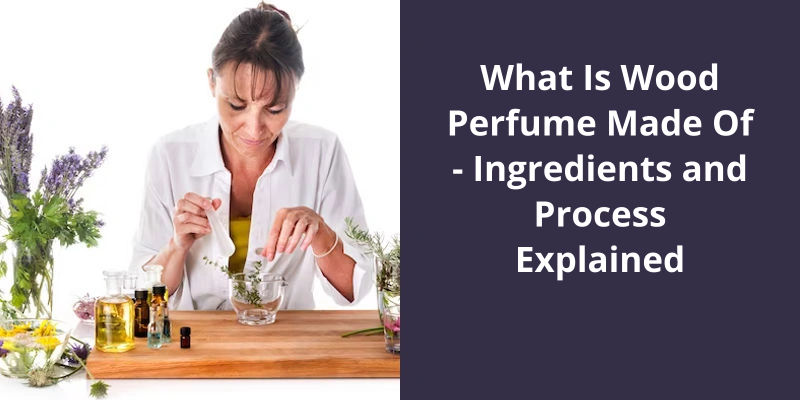Wood perfume is made from essential oils, often sourced from different types of trees such as cedar, sandalwood, and pine. These fragrant oils are then combined with a solvent like alcohol to create the final perfume product. Some wood perfumes may also contain additional aromatics, from spices or citrus, for a complex scent profile. The process involves careful blending and often aging of the perfume to allow the scents to meld together. The woody notes of these perfumes make them popular choices for both traditional and niche fragrances.

What Wood Is Used in Perfume?
Wood perfumes are highly sought after for their unique and alluring scents. But what exactly is wood perfume made of? The answer lies in the specific types of wood that are used in the fragrance-making process. Some of the most commonly used woods for perfumes include sandalwood, cedar, oak, pine, cypress, and oud. These woods are known for their aromatic properties and are often chosen for their ability to evoke a certain mood or ambiance.
Sandalwood is prized for it’s rich, warm, and creamy scent. It adds depth and complexity to perfumes, making them more enticing and sophisticated. Cedarwood, on the other hand, exudes a fresh and woody aroma that can be both calming and uplifting. It’s often used in perfumes that aim to capture the essence of the great outdoors or evoke a sense of tranquility.
It adds character and strength to fragrances and is often used in more masculine scents. Pine and cypress oils, on the other hand, offer a refreshing and invigorating scent, reminiscent of a forest after rainfall.
One intriguing wood used in perfumery is oud, also known as agarwood or aloeswood. This rare and precious wood is highly valued for it’s deep and complex fragrance. Oud emits an exotic aroma that’s both sweet and woody, often described as musky or spicy. It’s often used as a base note in perfumes, providing a long-lasting and captivating presence.
Patchouli and vetiver are also classified as wood fragrances, even though they don’t come from actual wood. Patchouli has a distinct earthy and herbaceous scent that adds depth and sensuality to fragrances. Vetiver, on the other hand, exudes a smoky and earthy aroma reminiscent of freshly cut grass. These ingredients are often used as fixatives and base notes in wood perfumes, anchoring the fragrance and adding depth and complexity.
In the process of creating wood perfumes, the essential oils or extracts from these various woods are extracted and carefully blended with other ingredients such as floral notes, citrus oils, and spices. This artful combination allows perfumers to create unique and captivating fragrances that capture the essence of nature, transporting the wearer to a world of warmth, tranquility, and mystery.
Different Techniques Used to Extract Essential Oils From Wood for Perfume Production
There are several techniques used to extract essential oils from wood for perfume production. One method is distillation, where the wood is heated in water or steam to release the aromatic compounds. Another method is solvent extraction, where solvents like ethanol or hexane are used to dissolve the essential oils from the wood. Steam distillation is also a common method, in which steam is passed through the wood chips to extract the oils. Finally, cold pressing can be used for certain types of wood, where the oils are extracted by applying pressure. These various techniques allow perfumers to capture the unique scents found in different types of wood for use in perfumes and colognes.
The earthy and woody scents offered by Pure Fragrance Oils are a unique olfactory experience that taps into the grounding power of nature. With notes of cedar, wood, amber, musks, and more, these fragrances capture the essence of walking through a serene forest, surrounded by the soothing aromas of pine and cut wood. The combination of these natural elements creates a scent that nurtures balance, centering both the mind and spirit.
What Is Earthy and Woody Scent?
They evoke a sense of being in the great outdoors, in a dense forest or a log cabin surrounded by trees. The earthy and woody scent is often associated with a sense of calm and tranquility, bringing us back to our roots and connecting us with nature.
Pure Fragrance Oils earthy and woody scents are carefully crafted using a combination of natural and synthetic ingredients. Cedarwood oil, which is extracted from the bark of the cedar tree, is a key component in many earthy and woody fragrances. It’s warm, rich and woody aroma adds depth and complexity to the scent.
Another important ingredient is sandalwood oil, derived from the heartwood of the sandalwood tree. Sandalwood is known for it’s creamy, woody and slightly sweet scent, which adds an exotic and sensual touch to the fragrance. Patchouli oil, extracted from the leaves of the patchouli plant, is also commonly used in earthy and woody fragrances. It’s a deep, earthy and musky aroma that’s both grounding and soothing.
Other resins, such as frankincense and myrrh, are often added to enhance the earthy and woody quality of the fragrance. These resins have been used since ancient times for their aromatic and therapeutic properties. They add a touch of spirituality and mysticism to the scent, evoking a sense of connection with the divine and the ancient.
In the process of creating wood perfume, the fragrance oils are carefully blended together to achieve the desired balance and complexity. The perfumer takes into consideration the top, middle and base notes to ensure that the fragrance evolves over time, revealing different facets of the scent. The result is a unique and captivating fragrance that captures the essence of nature and brings it to life.
The Artistic and Creative Aspects of Blending Earthy and Woody Fragrances.
- Explore the combination of natural scents
- Unleash your creativity with earthy and woody notes
- Find inspiration in the outdoors
- Create your own signature fragrance blend
- Experiment with different essential oils
- Discover the allure of sandalwood and patchouli
- Channel the earth’s beauty with mossy notes
- Add depth with hints of cedar or vetiver
- Let your senses escape to a tranquil forest
- Embrace the calming effects of woody aromas
Now that you’ve learned the first step of how to scent wood, let’s move on to the next step that will help you create a pleasant and aromatic atmosphere in your living space.
How Do You Make Wood Fragrance?
Creating a wood fragrance involves a simple and straightforward process that allows you to infuse wooden objects with delightful scents. The first step in this process is selecting the scented aromatherapy or essential oil that you desire for your wood fragrance. You’ve the freedom to choose from a diverse range of scents, including lavender, sandalwood, cedar, or any other aroma that pleases your senses.
Once you’ve decided on the fragrance, you can proceed by placing a sufficient amount of the scented aromatherapy or essential oil in a container or on a small bowl or plate. This will serve as the medium through which the wood will absorb the scent. It’s important to ensure that the container is tight-sealed to prevent any evaporation of the fragrance.
Make sure to coat the entire surface of the wood evenly. The oil will penetrate the porous surface of the wood, allowing the scent to be absorbed over time. You can use a brush or a cloth to apply the oil, ensuring that it’s distributed evenly and gets into all the nooks and crannies of the wood.
This container can be a jar, a Ziplock bag, or any other airtight vessel that can accommodate the size of your wood. Let the wood sit overnight in this closed container to give it enough time to soak up the aroma.
Once the wood has had sufficient time to absorb the scent, remove it from the container and inspect it. You’ll notice that the wood has taken on the fragrance, emanating a pleasant aroma. At this point, you can choose to leave the wood as is, or you can take it a step further and create an air freshener by attaching a string or ribbon to the wood and hanging it in your desired location.
The process isn’t only enjoyable but also allows you to experiment with various scents and personalize the fragrances according to your preferences. So go ahead and indulge in the exquisite experience of crafting your own wood perfumes.
Driftwood is known for it’s unique and intriguing aroma, and when incorporated into perfume, it adds a touch of natural allure to the overall fragrance. The scent of driftwood in perfume is often described as fresh and airy, evoking the feeling of being near the ocean. With salty ocean notes as it’s foundation, the perfume captures the essence of the seaside, while the star jasmine signature adds a touch of floral elegance. To further enhance the olfactory experience, specialty mint notes are added, providing a refreshing and invigorating element to the fragrance. Together, these carefully crafted notes create a driftwood perfume that’s both captivating and irresistible.
What Does Driftwood Smell Like in Perfume?
Driftwood is known for it’s unique scent that evokes images of the ocean and beach. When used in perfume, the scent of driftwood adds a distinctive and refreshing element to the fragrance.
In a driftwood perfume, you can expect to find salty ocean notes as a prominent aspect of the scent. These oceanic notes help create a refreshing and aquatic ambiance, reminiscent of a coastal breeze. Additionally, a star jasmine signature adds a touch of floral sweetness, adding depth and complexity to the fragrance profile.
To further enhance the driftwood scent, specialty mint notes are incorporated into the perfume. Mint brings a cooling and invigorating effect, serving as a complementary element to the salty and fresh aspects of the fragrance.
They carefully select and blend different aromatic components, taking into account factors such as the strength, longevity, and overall character of the fragrance.
The result is a beautiful and captivating driftwood perfume that captures the essence of the ocean and evokes memories of tranquil beachside moments. It’s a fragrance that can transport you to sandy shores, offering a sense of calm and serenity wherever you go.
How Driftwood Is Sourced and Collected for Perfumes
Driftwood, often used in the creation of wood perfumes, is sourced and collected from various water bodies such as rivers, lakes, and oceans. As a result of natural processes like erosion and weathering, pieces of wood break off from trees and are carried downstream by flowing water, eventually reaching shorelines or accumulating in bodies of water.
Perfume makers search for driftwood along coastlines and shores, selecting pieces that exhibit unique aromas and desirable qualities. Once collected, the driftwood undergoes a thorough cleaning process to remove any impurities or contaminants. This ensures that the final fragrance derived from the wood will be pure and free of any unwanted elements.
The cleaned driftwood is then typically dried and aged to further enhance it’s scent and extract the desired fragrance compounds. This can be done naturally by exposing the wood to the elements over a period of time, or through controlled processes that accelerate the aging process.
Finally, after aging, the driftwood is processed to extract it’s scent and capture it’s aromatic essence. This can be achieved through various methods, such as distillation or extraction using solvents. The resulting extract is then blended with other ingredients to create unique wood perfumes that captivate the senses and evoke nature’s beauty.
Source: Driftwood Fresh Ocean from Wild Spirit
Earthy perfumes are often crafted with a blend of perfumed herbs, barks, mosses, patchouli, and resins. These ingredients add fresh, green, and woody facets to the fragrance, creating a unique scent experience. While perfumed herbs like lavender, geranium, basil, cumin, rosemary, and sage provide a masculine touch, the inclusion of barks, mosses, and patchouli softens and warms the overall aroma.
What Are the Ingredients in Earthy Perfume?
When it comes to earthy perfumes, the ingredients used are crucial in creating the desired scent profile. Perfumed herbs, including lavender, geranium, basil, cumin, rosemary, and sage, play a vital role in adding fresh and green facets to woody notes. These natural elements are often more commonly found in masculine fragrances, adding depth and complexity.
In addition to perfumed herbs, barks, mosses, patchouli, and sometimes resins are frequently included in earthy perfume compositions. These ingredients serve to soften and warm the scent, creating a more rounded and comforting olfactory experience. Barks, for instance, can provide a rich and earthy aroma, while mosses contribute a damp and green quality. Patchouli, on the other hand, adds a unique depth and intensity to the fragrance.
The inclusion of resins in earthy perfumes can also have a profound impact on the overall scent profile. Resins, such as frankincense or myrrh, not only add a touch of sweetness but also possess an intriguing smoky or incense-like quality. These resins often contribute to a more mysterious and alluring fragrance.
The process of creating a wood perfume involves carefully selecting and blending these ingredients to achieve the desired olfactory result. Perfumers utilize their expertise to balance the various components, ensuring that the final product is harmonious and evocative.
The Environmental and Sustainability Aspects of Using Natural Ingredients in Perfumes, Including the Impact on Ecosystems and the Importance of Sourcing Ingredients Responsibly
- Natural ingredients in perfumes have various environmental and sustainability benefits.
- Using natural ingredients reduces the reliance on synthetic chemicals that can harm ecosystems.
- Choosing responsibly sourced natural ingredients helps protect biodiversity.
- Natural ingredients are often biodegradable, reducing pollution and waste.
- Using natural ingredients supports local communities and promotes ethical practices.
- Proper sourcing and harvesting of natural ingredients helps ensure their long-term availability.
- Natural ingredients can provide unique and authentic fragrances.
- By using natural ingredients, perfumes can contribute to a more eco-friendly and sustainable fragrance industry.
Conclusion
When these trees are infected by the phialophora fungus, they secrete a dark and fragrant resin called oud wood. The process of extracting the resin from the infected trees requires great care and expertise, as it’s a delicate and time-consuming process. Once obtained, the oud wood resin is then meticulously blended with other ingredients to create exquisite wood perfumes that evoke a sense of sophistication and allure.





